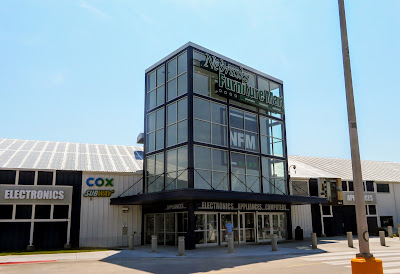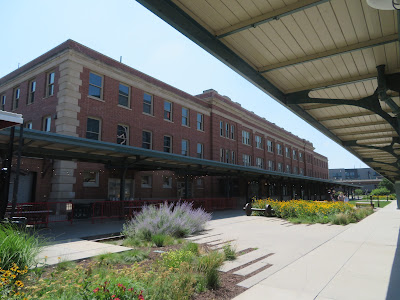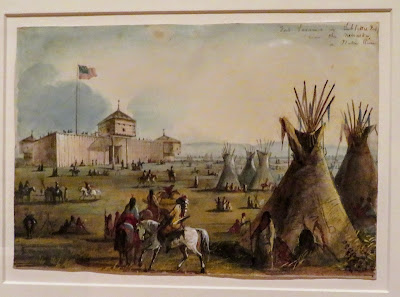Following
our trek along the interstate highways and back roads through Tennessee,
Kentucky, Illinois, Missouri and Iowa, Laurie and I finally reached our destination in
Omaha Nebraska! We had a nice dinner
waiting for us and plenty of time for visiting…and then it was time to get out and
about in Omaha.
Our first
family adventure was a visit to the Joslyn Art Museum. As the primary photographer, I am able to
avoid most group photos. In this
instance, from left to right are Emmett (youngest grandson, Laurie (my better
half), David III (oldest grandson), David II (#1 son) and Amy (DII’s better
half)
The
museum was opened in 1931 in memory of George A. Joslyn by his widow,
Sarah. George Joslyn became wealthy by
creating a virtual monopoly in the ‘auxiliary’ printing business. His company, Western Newspaper Union,
supplied standardized, preprinted news to more than 12,000 newspapers
throughout the USA. At its peak, WNU had
31 plants in 25 states and Joslyn was the wealthiest man in Nebraska.
The
Joslyn Art Museum is the primary fine arts museum in Nebraska. It is housed in a striking Art Deco building
that is constructed with pink marble from the State of Georgia. The decorative panels around the outside of
the building, (note the upper right of the photo), were designed by sculptor
John David Brcin. (1899 – 1983) The decorative panels on the exterior of the
museum refer to the peoples of the plains…from the original Native Americans to
subsequent European explorers and settlers.
The
Joslyn Sculpture Garden is a relatively new addition to the museum. It opened in 2009 and it features works from
local and national artists. The first
photo shows a sculpture by Tom Otterness entitled “Large Covered Wagon” (2004). Otterness is one of America’s most prolific
public artists. His works are on display
in parks, plazas, subway stations, libraries, courthouses and museums around
the world.
The
statue entitled “Sioux Warrior”, on a rearing horse is based on a model by
previously mentioned Serbian-born sculptor John David Brcin. He completed a model of this sculpture in the
late 1920s…for the entrance to the museum.
He never took this project to the next step and in 2009, sculptor
Matthew Placzek was commissioned to create this eye-catching 15 foot tall,
5,000 lb. bronze sculpture. The warrior
and his horse sit on top of a 6 foot base of concrete that is encased in Lake
Superior green granite.
If you’ve
visited any art museum, formal botanical garden or other artistically inclined
venue in the last few years, you have seen blown glass works by Dale Chihuly (1941 - ) They seem to be everywhere!
This
giant glass creation was completed in 2000 and it’s entitled “Inside et Out”. Still, this isn’t Chihuly’s largest permanent
exhibit. His biggest artistic glass
creation is found at the Oklahoma City Museum of Art. Chihuly is more than an artist…he is also a
bit of an entrepreneur. He has 2 retail
stores, one in the Bellagio in Las Vegas and the other at the MGM Grand Casino
in Macau.
Charles
Marion Russell (1864 – 1926) along with Frederic Remington, are perhaps
America’s pre-eminent artists as regards depictions of the old American
west. This work by Russell is titled “A
Serious Predicament” (1908). Russell
worked as a cowboy in his youth and he lived in Montana for most of his
life. He took a lot of pride in the
accuracy of his ranch scenes and his works are usually full of action and
adventure.
Note: I took many, many more photos of the various exhibits than are posted here. This is just a representative glance at the total collection at the Joslyn Art Museum.
This next
painting is titled “Sunlight and Shadow”.
The artist was William Merritt Chase (1849 – 1916) Does the painting
tell a story? The man fiddles with his
teacup and a cigarette while the woman in the hammock peeks over her shoulder
and peeks out at the viewer as if involving us in this little drama. The painting was originally called “The
Tiff”. This painting was completed in
Holland where Chase was staying for the summer.
Chase was
a model for progressive American artists of his time. He spent as much time traveling abroad as he
did in the USA. He studied art at the
National Academy of Art in New York City as well as at the Munich Royal
Academy. With exhibits in Munich and
London, he was already well known by the time he returned to America.
This
beautiful Native American Indian jacket made from hide, silk and bone was
created by an unknown artist/craftsperson ca. 1850. Unlike traditional Plains hide clothing,
coats and jackets appear to have been adapted from Canadian or US fashions,
often from military styles.
This
particular jacket is reputed to have belonged to Logan Fontenelle (1825 – 1855,
a notable figure in Omaha Indian history.
His father was a prominent French trader and his mother was the daughter
of Big Elk, a well-known Omaha Chief.
Educated in St. Louis, Fontenelle was fluent in English, French and
Omaha and he frequently served as an interpreter. He moved with his people to a new Omaha Indian
Reservation in northeastern Nebraska, but his plea for US Army protection
against attacks by the Sioux were ignored.
Fontenelle was killed by the Sioux raiding party in 1855.
Although
the most famous artist’s names appear in the Joslyn Museum’s European and
American collection, the Western American and Native American collections may
have the greatest importance as a group.
These extensive collections provide a rare opportunity to study these
genres and periods of art and they allow for a critical insight into the
history of the American west.
This
watercolor is titled “Fort Laramie or Sublette’s Fort next to the Nebraska or
Platte River” ca. 1837. This painting is
one of Alfred Jacob Miller’s many depictions of the American West. Miller lived from 1810 to 1874. In 1837, William Drummond Stewart (Scottish,
1795 – 1781) asked Miller to join him on an adventure into the Rocky Mountains
where he could record the scenes and events witnessed. Some of Miller’s works later hung in
Stewart’s castle in Scotland and the Joslyn Museum is in possession of several
works by the artist.
Some
beautiful furniture from different periods and genres are on display throughout
the museum. This spectacular
Massachusetts Chest on Chest, made with maple and pine, was built ca.
1750. The craftsman is unknown.
Mary
Cassatt (1844 – 1926) is the most recognized female artist who was associated
with the impressionist era in art. In a
world of male impressionist artists…mostly French…this American woman was
highly regarded by the public and other artists. No less than Edgar Degas invited Cassatt to
join the impressionists in a series of historic exhibitions in Paris in the
1870s and 1880s.
This
particular paint is titled “Woman Reading” and it was completed in 1879. Cassatt was the daughter of an elite
Philadelphia family and she was in a position socially where she could
influence friends to patronize and purchase this ‘new’ art form.
This oil
painting is titled “The Vintage at Chateau Lagrange”. It was completed in 1864 by French artist
Jules Breton (1827 – 1906). Breton was a
French Naturalist painter and his paintings of the rustic life were heavily
influenced by the French countryside.
Unlike
many painters of his time, Breton was both popular and a financial success
during his lifetime. His painting “The
Communicants” (1884) sold for $45,000 in 1886, the same year that Breton was
made a Commander of the French Legion of Honor.
FYI, the same painting sold again in 2016, this time for
$1,270,000…which is the rough equivalent to the original purchase price in 2016
dollars.
Antoine-Louis
Barye (1795 – 1875) was a Romantic French sculptor who was most famous for his
work as a sculptor of animals. This
bronze, “Tiger Attacking an Antelope” was modeled by Barye in 1836. Although it seems much larger, this
beautifully ‘animated’ sculpture only measures 13 x 21 ¾ x 11 inches.
Barye
certainly excelled at sculpture but he lacked business acumen. In 1848 he was forced to declare
bankruptcy. All of his work and his
molds were sold to a foundry that produced poor quality sculptures for 9 years,
impacting Bayre’s reputation. Finally, in
1876, a top notch foundry acquired his remaining 125 models…and the quality was
superb. Unfortunately, the artist had
died the year before…
I like
action and I like paintings involving the sea and ships. Hence, “The Smuggler’s Return”, an oil on
canvas, caught my eye. It’s the work of
Philip James de Loutherbourg (1740 – 1812).
Loutherbourg was a French-born British painter who became especially
well-known for his large naval paintings.
One of my favorites is “The Battle of Camperdown” in 1799.
Loutherbourg
was creative…playing with lights and motion to create a form of theater called Eidophusikon,
meaning “image of nature”…basically a miniature mechanical theatre. When he first came to London he was hired at
the famous Drury Lane Theatre to create scenery and costumes. He received much acclaim for his creativity…
Loutherbourg was made a member of the Royal Academy in 1781. An eclectic man, in 1789, he began pursuing
an interest in alchemy and the supernatural.
He and his wife also took up faith-healing…
This
painting is titled “Portrait of Nicolaes Willemsz Lossy and his wife Marritgen
Pieters”. This oil on panel work was
completed in 1633 by Gerard Donck. (Dutch – 1600 to 1650) He painted during
what is referred to as the Dutch Golden Age (1588 – 1672)
FYI, the
Dutch Golden Age is a period in the history of the Netherlands in which Dutch
trade, science, art and the Dutch military were the most acclaimed in the
world. The birth of the Dutch Republic
took place in 1588, and that marked the beginning of this amazing period in
Dutch history. In the end, the
Franco-Dutch War and the War of the Spanish Succession brought about economic
decline. To learn more about the extent
of Dutch dominance during this period, just go to Dutch Golden Age - Wikipedia.
The
Joslyn Museum also offers a striking exhibit of religious art. In this instance, this polychromed wood
sculpture depicts Saint Stephen. It was
completed ca. 1480 but the Austrian artist is unknown. The figure of Saint Stephen is just a little
over 42 inches tall.
Laurie
and love the many works of Thomas Hart Benton. (1889 – 1975) This painting is
titled “The Hailstorm” and it was completed in 1940. This painting is ‘pure’ Benton…with its rural
theme, use of color, exaggerated figures and the rolling landscape. He is depicting the drama between man and
nature. Note that Benton also included that
most stubborn of creatures in people’s minds, the Missouri mule.
Benton
was a Missouri native as well as an outspoken populist. His paintings present what he viewed as
ordinary American virtues. Characters
are rough-hewn and colorful and his works are full of social commentary. Benton produced many murals and inexpensive
lithographs because he believed that this effort would provide greater public
access to his works.
This
display is full of amazing artistic creations by Native Americans. At the top is that amazing hide and beadwork
Rifle Scabbard ca. 1900. It was made by
Edith Claymore of the Standing Rock Sioux. (1858 – 1910)
The two
colorful beaded bags at the center are Utah/Ute Ration Ticket Bags…beauty for
such a sad thing…from ca. 1890. Artists
unknown.
The large
Medicine Pouch at the bottom is from the Sioux in the 1800s. Artist unknown.
The
museum has an Asian arts section too…but on this occasion I scattered my
photos, focusing primarily on the American West. However, as my bride loves horses and we both
love Asian art, I’ve included this outstanding earthenware with polychrome “Tomb
Figure of a Horse”, Chinese, Tang Dynasty (618 – 907)
This pair
of sculptures are across from each other at the opening to the central
courtyard at the Joslyn museum. The “Indian
Hunter and Pronghorn Antelope” were created in 1917 by American artist Paul
Manship (1855 – 1966). Manship actually gifted these works to the Museum. These striking plaster figures are painted in
bronze and they fit perfectly with the Art Deco décor that enlivens the core of
the museum.
When
studying in Greece, Manship found the he loved Archaic Greek art with its
directness and simplified naturalism.
This work recasts the heroic mortal Herakles as a Native American
wounding his western quarry. Originally,
Mandship had designed these figures as two small sculptures for the mantle in
his home. These large painted plaster
figures are the plasters or bases used to cast a bronze pair for an admiring
collector.
The Storz
Fountain Court with its fountain as the central focus, has so many features,
many of them symbolic, that it is a bit overwhelming. The thunderbird motif around the courtyard,
the wing shaped light fixtures, the grill work on the windows…and of course the
marble…amazing! The floor tiles are
Moravian and they include symbols for literature, music, architecture and
painting.
The art
déco design were even an influence for the corridors leading to the galleries. As you can see, they are quite spectacular! They were made with white Botticino marble
and Badger pink floors. A total of 38
different marbles from around the world were used to finish the interior of
this beautiful building. My one regret from
our visit is that I didn’t take more photos of the building, especially of the
interior.
Did I
mention the admission to the Joslyn Art Museum is free?! However, there is a very nice gift shop available
that helps defray operating costs and donations are also accepted. The museum is open from 10 AM until 4 PM
Wednesday through Sunday. Free parking
is available. Phone: 402-342-3300. Address: 2200 Dodge Street, Omaha
Nebraska. Website: https://www.joslyn.org/.
This was
a very enjoyable and educational family outing.
Just click on any of the photos to enlarge them…
Thanks
for stopping by for a visit!
Take
Care, Big Daddy Dave



























































